Study: Consumer expenditures during COVID-19: An exploratory analysis of the effects of changing consumption patterns on consumer price indexes
Archived Content
Information identified as archived is provided for reference, research or recordkeeping purposes. It is not subject to the Government of Canada Web Standards and has not been altered or updated since it was archived. Please "contact us" to request a format other than those available.
Released: 2020-07-13
In partnership with the Bank of Canada, Statistics Canada has developed an Analytical price index, based on derived basket weights reflecting consumer expenditures during the months of the COVID-19 pandemic.
The analytical paper "Consumer expenditures during COVID-19: An exploratory analysis of the effects of changing consumption patterns on consumer price indexes" provides detailed information on the data and methods used to calculate the Analytical price index series, as well as estimates and analysis of the inflation experienced by consumers during the months of March, April and May 2020.
COVID-19 and consumer price inflation
The COVID-19 pandemic led to economic disruptions that affected financial and labour markets across the globe. Canadians quickly began spending less and spending differently as they adapted to staying home, travelling less and buying more of certain items, like cleaning products and non-perishable foods.
Shifts in household purchasing patterns have implications for the basket weights used to measure consumer price inflation. A fixed-basket price index, such as the Consumer Price Index (CPI), can only reflect these changes when the basket weights are updated.
In partnership with the Bank of Canada, Statistics Canada obtained temporary access to aggregate, current expenditure data representing nearly all consumer goods and services. These data reflect the new consumption patterns that evolved during the COVID-19 pandemic and were used to derive the basket weights used to calculate the Analytical price index. This analytical series provides an alternative estimate of consumer price inflation during the first few months of the pandemic.
Results
In April, the first full calendar month characterized by the COVID-19 pandemic in Canada, the largest differences between the official basket weights and derived basket weights were observed. Canadians directed more of their spending in April to shelter and food components, expenses that tend to be fixed in the short term. The proportion of consumer expenditures on transportation had the largest drop as a result of lower expenditures on passenger vehicles, air transportation and gasoline. The derived basket weights for recreation, education and reading, and clothing and footwear also declined. With non-essential stores closed, many products and services in these categories became unavailable or more difficult for consumers to access.
Overall, the Analytical price index showed smaller month-over-month declines in March and April compared with the official CPI.
In April, the largest difference between the official CPI and the Analytical price index was in the clothing component. Prices for clothing and footwear fell at a record pace from March to April, contributing significantly to the month-over-month decline in the official CPI. The closure of non-essential retail resulted in price effects as retailers discounted seasonal stock online to move inventory. This decline took on less importance in the Analytical price index following a large, concurrent drop in clothing purchases.
While consumers were buying some products in lower-than-usual quantities, they also substituted toward other products. Higher prices for non-perishable foods such as soup, infant food, frozen food and snack products, took on more importance in the Analytical price index.
Based on the analysis so far, the annual average increase for the 12-month period ending in May 2020 is the same (+1.6%) for the official CPI and the Analytical price index. This means that while a specific consumption pattern may prevail at some point during the life of the CPI basket, the resulting difference in headline consumer price inflation would have to be sustained for a longer period in order to have a subsequent impact on the annual average CPI.
Ongoing work
The Analytical price index provides insight into how consumer price indexes can be affected by sudden, extreme shifts in purchasing patterns, and the specific impact of COVID-19 on the Canadian CPI. The continuation of this work relies on regular access to timely, reliable expenditure information at the required level of detail. This information will allow Statistics Canada to monitor how consumer spending patterns evolve during the pandemic; help inform the methods, sources and frequency of future CPI basket updates; and facilitate other research around measures of inflation for different groups, as well as on household types and geographies.
Products
The analytical paper "Consumer expenditures during COVID-19: An exploratory analysis of the effects of changing consumption patterns on consumer price indexes" is now available as part of the Prices Analytical Series (62F0014M).
Contact information
Statistics Canada welcomes feedback on this experimental work. Questions and comments can be directed to statcan.cpddisseminationunit-dpcunitedediffusion.statcan@canada.ca.
For more information, or to enquire about the concepts, methods or data quality of this release, contact us (toll-free 1-800-263-1136; 514-283-8300; STATCAN.infostats-infostats.STATCAN@canada.ca) or Media Relations (613-951-4636; STATCAN.mediahotline-ligneinfomedias.STATCAN@canada.ca).
- Date modified:



